It can take time to set a story straight, even one as public and long-awaited as the mass immigration of Ethiopian Jews to Israel.
More than 40 years after Beta Israel, as the Ethiopian Jewish community is also known, was airlifted to Israel in a series of rescue operations deemed heroic and historic, the community is still experiencing poverty, racism and an ongoing struggle for full acceptance in the Jewish homeland.
Eyed with suspicion by the ruling Orthodox establishment, which has questioned their Jewishness, community members face police brutality, discrimination at some semi-private religious schools that refuse to admit them, and significant disadvantages in the job market, even for second-generation Ethiopian-Israelis.
To many in the community, the prejudice extends even to the way the story of their exodus to Israel is told — a narrative that until now has portrayed Ethiopians as helpless bystanders who were rescued only when Israel and North American Jews stepped in. Now they are reclaiming that story and sharing lesser-known details of Beta Israel history in an effort aimed at altering attitudes and helping younger generations of Ethiopian Israelis learn their heritage.
“This is a public effort to expand the Ethiopian story,” said Shmuel Yilma, founder of the Yerusalem Forum, one of the organizations leading the effort to raise Beta Israel consciousness.
Get The Times of Israel's Daily Edition by email and never miss our top stories
Beta Israel activists, including those of Ethiopian origin and others who have long labored on behalf of the community, want the world to know that the rescue effort to bring Ethiopian Jews to Israel was begun by Ethiopian Jews themselves, despite police imprisonment and threats. While the North American Jewish community and the State of Israel played essential roles, the community’s flight to Israel was a local initiative led by its own members.
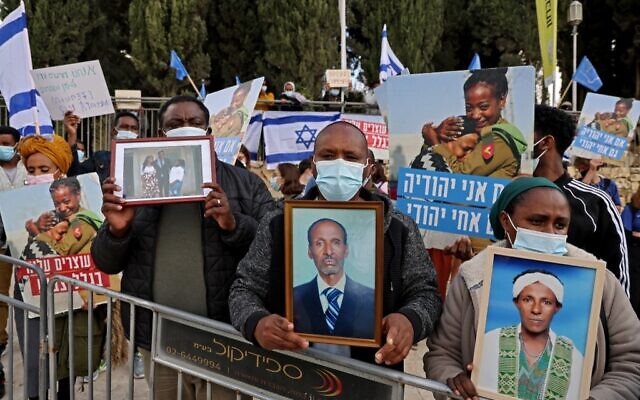
Members of the Ethiopian Israeli community hold up photographs of their relatives outside the Prime Minister ‘s Office in Jerusalem on November 25, 2020 (Menahem Kahana / AFP)
“It’s not a matter of credit, who did what and how much,” said Rahamim Elazar, a speaker and activist for the Ethiopian community. “It’s a matter of changing Israeli policy toward the Ethiopian community.”
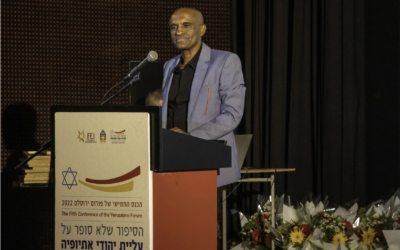
Yerusalem Forum founder Shmuel Yilma speaking at the recent Beta Israel conference in Tel Aviv, in November 2022 (Courtesy Yerusalem Forum)
Yilma wants Ethiopian youth to be proud of the community’s elders, and Israeli society to know and recognize Ethiopian-Israeli heroes. He wants Israeli streets and squares named after Ethiopian activists. He’s pushing for an educational curriculum in the Israeli school system that relates Beta Israel history, and more organizations and institutions dedicated to exposing the full story of Ethiopian heroism.
“Ethiopians don’t get equal treatment in Israel. There was a problem of low expectations, a lack of opportunities, racism,” said Yilma, who founded Yerusalem Forum in 2017. “I understood that in order to fix all that, it had to come from the community itself.”
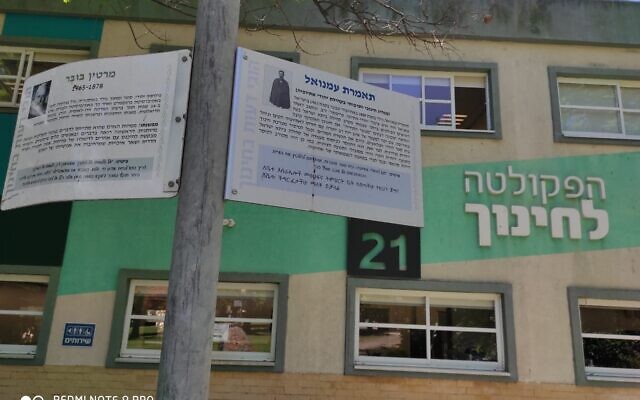
Educational signage about Ethiopian Jewish heroes at the Kibbutzim Seminar campus (Courtesy Yerusalem Forum)
The effort was front and center at the fifth Yerusalem Forum conference held in November in Tel Aviv, where hundreds of Israeli and North American activists gathered to recount the details of the community’s exodus from Africa.
Some in the audience had never have heard parts of this history.
The most well-known part of the story is the airlifts, a series of operations in the mid 1980s and early 1990s that brought some 30,000 members of the community to Israel, first via Sudan and then directly from Addis Ababa.
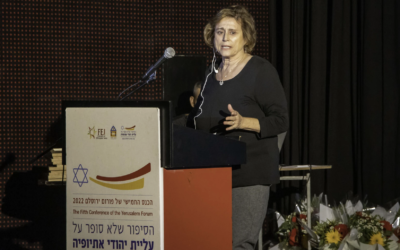
US activist Susan Shapiro got involved in the Beta Israel cause after hearing activist Rahamim Elazar speak in Israel in 1981 (Courtesy Yerusalem Forum)
“The airlifts were wonderful and dramatic but they were only the last few days of the process,” said Susan Shapiro, a longtime US activist. “We’re here to tell you what happened before the airlifts.”
Shapiro became involved in the Ethiopian rescue efforts after visiting Israel in 1981 and hearing a lecture given by Elazar and another activist. She learned about the-then Marxist military government in Ethiopia, its civil war, drought and the community’s decision to try and decamp for Israel via Sudan.
“The Ethiopian community is often portrayed as helpless victims waiting for Israel to save them. Nothing could be further from the truth,” said Shapiro.
Until the mid 1970s, most members of the community who had applied to move to Israel were turned away due to questions over their Jewish heritage. That year, chief Sephardic rabbi Ovadia Yosef ruled that the Beta Israel were halachically Jewish, cracking open the door to immigration.
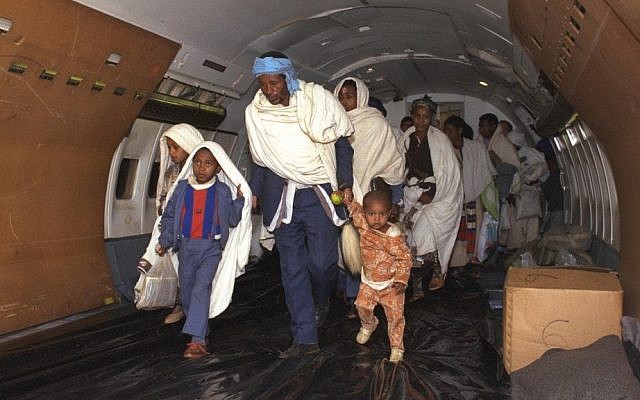
New Ethiopian immigrants boarding an aircraft en route from Addis Ababa to Israel during Operation Solomon, 1991. (Natan Alpert/GPO)
Getting to Israel was another matter. The emigration of the Beta Israel community was officially banned by Ethiopia’s communist government during the 1980s, so many Jews fled the country on foot for refugee camps in Sudan, a fraught journey that took from two weeks to a month and was often ridden with illness and violence.
Eventually, community leaders, activists and Israeli officials managed to organize the airlifts to the Jewish homeland.
The first major airlift was 1984’s Operation Moses, in which 15,000 Ethiopians were brought to Israel through Sudan in secret. But when the Israeli press published news of the airlift, the Sudanese government reacted angrily and shut the operation down.
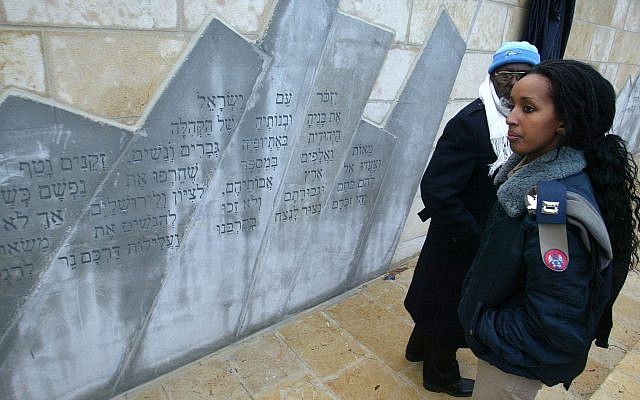
An Ethiopian Jewish Israeli army Officer walks in front of a memorial to the Ethiopian Jews lost on their way to Israel, at Mt. Herzl in Jerusalem, March 14, 2007. (Olivier Fitoussi /Flash90 /Israeli Pool)
Ethiopia and Israel restored diplomatic relations in 1989, and starting in 1990, Addis Ababa began allowing small numbers of Beta Israel to emigrate. Worsening conditions in the country added urgency to the community’s flight. In 1991, as rebel forces pushed into the Ethiopian capital, then-president Mengistu Haile Mariam fled to Zimbabwe, and Israel began an extraordinary operation that would see almost 15,000 community members airlifted from Addis Ababa in the course of two days.
The community’s priestly kessim, rabbis and elders, along with community activists, were the masterminds of the exodus, said Shapiro, while allies they recruited, mostly North American Jews and politicians, would pay the expenses and bribes.
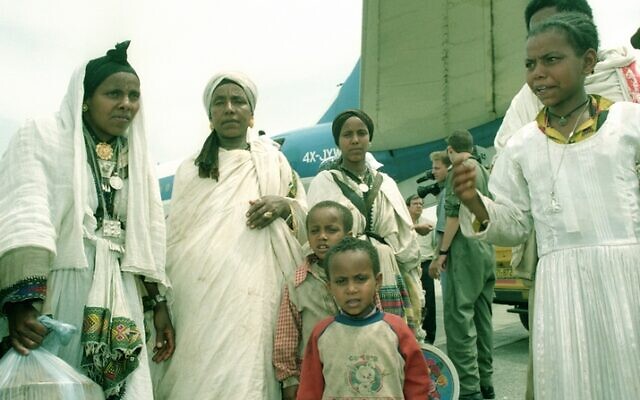
New immigrants from Ethiopia shortly after disembarking from the plane as part of Operation Solomon, 25 May 1991. (Photo: Gadi Cavallo/Dan Hadani Archive, Pritzker Family National Photography Collection at the National Library of Israel)
“They orchestrated their own escape,” said Shapiro. “Their plan was to take everyone left in Gondar and Tigray and from 300 villages and bring them to Addis Ababa because that was the only place big enough to land a 747. When everyone was in one place, they could do one airlift.”
Once the airlifts took place, however, the dominant narrative became that of a weak community that owed its survival to Israel’s dramatic, last-minute rescue.
Many Ethiopian-Israelis accepted the role of silent, passive refugee, rarely speaking about the traumas and hardships they went through to reach Israel.
“They didn’t really give it the value that it deserved,” said Shapiro. “So slowly, now it’s being given the legitimization that it deserves.”

Filmmaker Simkha Jacobovici became involved in the Beta Israel cause as a university student in Canada (Courtesy Forum Yerusalem)
The community’s relative silence about its role has filtered to younger generations as well.
“My children did not know my history. I never told them,” said Elazar. “My older son said, ‘I hear about you from other people and the only thing I know is that you’re my father.'”
Simcha Jacobovici, a Canadian-Israeli filmmaker behind the 1985 documentary “Falasha: Exile of the Black Jews of Ethiopia,” recalled that a friend of his daughter, born into a Beta Israel family, thought of her parents and grandparents as primitive people who wouldn’t have been rescued if not for the Israeli efforts.
Israel can be very proud of what it ultimately did without taking away from the accomplishments of the community itself, he commented.
“I’m all for praise but not for historical distortion,” said Jacobovici, who got involved with the cause while a university student in Montreal after hearing Ethiopian activist Baruch Tegen’e speak.
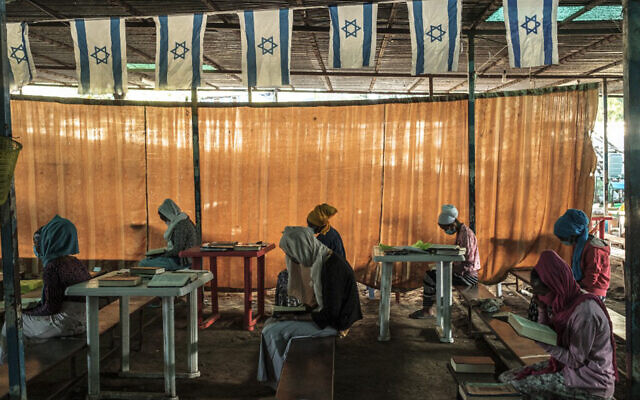
Members of the Ethiopian Jewish community attend a religious service at the synagogue in the city of Gondar, Ethiopia, on October 26, 2020. (Eduardo Soteras/AFP)
A child of Holocaust survivors, Jacobovici said he was moved to become active after hearing Tegen’e’s story about escaping through Sudan and helping lead the fight to save the Jews of Ethiopia. “This idea of passivity is just wrong.”
While safe from famine and war, the struggles for the community did not end once they reached Israel, where they continued to face systemic racism, poverty, discrimination and other difficulties.
It was a frustrating struggle, said Elazar, but the community was idealistic and remained focused on reaching the promised land, rather than getting bogged down in the weeds of navigating life in Israel.
“We never thought about jobs and housing,” said Elazar, who came to Israel in 1972 as a 14-year-old on an educational program after undergoing investigation and torture by Ethiopian authorities.
Reclaiming the story of their exodus is part of a larger project aimed at combating persistent racism.
Are you Jewish?
Israeli attitudes can be traced back to how the government initially viewed the community, refusing to recognize them as Jews and asking “so many questions,” said Elazar.
While the Beta Israel are considered one of oldest Diaspora Jewish communities, they were also among the most isolated, practicing a brand of Judaism that is unfamiliar to most modern-day Jews, who follow rabbinic precepts. The community’s unique traditions and rituals bore little relation to those practiced by the wider Jewish community today, but do reflect the time when the Temple stood in Jerusalem.
Debates over the authenticity of Ethiopian Judaism and their eligibility for immigration raged for decades.
“They asked why there were Black Jews, why weren’t they practicing modern Judaism, thinking that maybe they weren’t originally Jews,” said Elazar.
There weren’t any easy answers because the Ethiopian community didn’t have written material that could explain how Jews got to Ethiopia.
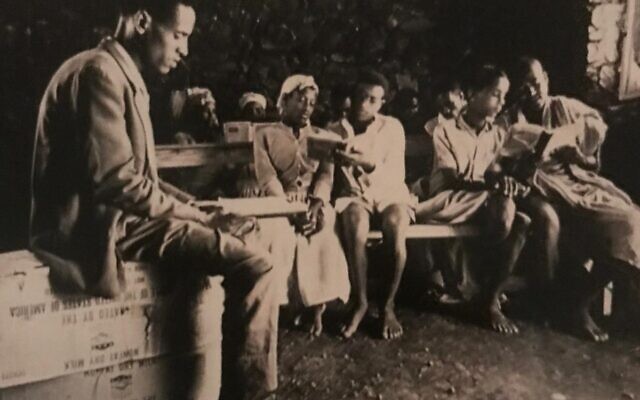
Rahamim Elazar, second from right, as a boy in Ethiopia, where three students had to share one workbook in his village school (Courtesy Rahamim Elazar)
An Ethiopian Jewish activist in Israel, Hezi Ovadia, specifically asked Rabbi Ovadia Yosef, Israel’s chief Sephardic rabbi, for a ruling that would enable the Beta Israel to settle in Israel, and in 1973, Yosef concluded that Ethiopian Jewry were Jews but would have to undergo a symbolic conversion.
The Ashkenazi chief rabbi of the time, Shlomo Goren, didn’t agree at first with Yosef, taking another two years, until 1975, to recognize Beta Israel as true Jews.
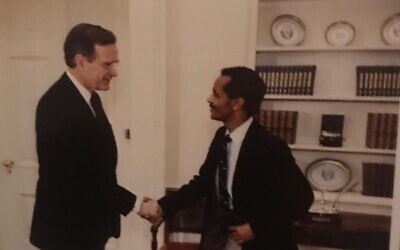
Activist Rahamim Elazar meeting US president George H.W. Bush in the White House (Courtesy Rahamim Elazar)
As the narrative shifts and expands, the younger generation will hopefully feel stronger and more empowered, said Yilma.
“It will take time,” he said. “As the Israeli public hears the stories, their view will change. People tell me that they didn’t know and they’re affected by what they hear.”
The Ethiopian-Israeli community needs equality, said Yilma, pointing to figures from a 2019 poll by Midgam Research & Consulting showing that 33 percent of Israelis don’t want their children to marry Ethiopian-Israelis, 22% doubt the Judaism of Beta Israel, 16% don’t want to live near Ethiopian-Israelis, 15% think allowing Ethiopian immigration was a mistake, 10% won’t work with an Ethiopian superior and 9% don’t want their children to learn about the Ethiopian community.
“It doesn’t matter that you’re the beauty queen of Israel if someone asks if you have an ID card,” said Yilma, who called the 2015 police beating of Ethiopia-born IDF soldier Damas Pakada an event that pushed many Ethiopians to the brink.
“It doesn’t matter if you have a great resumé or if you’re an excellent army officer,” he added. “Bigotry is an everyday reality of a real percentage of young Ethiopians and it has to change.”


